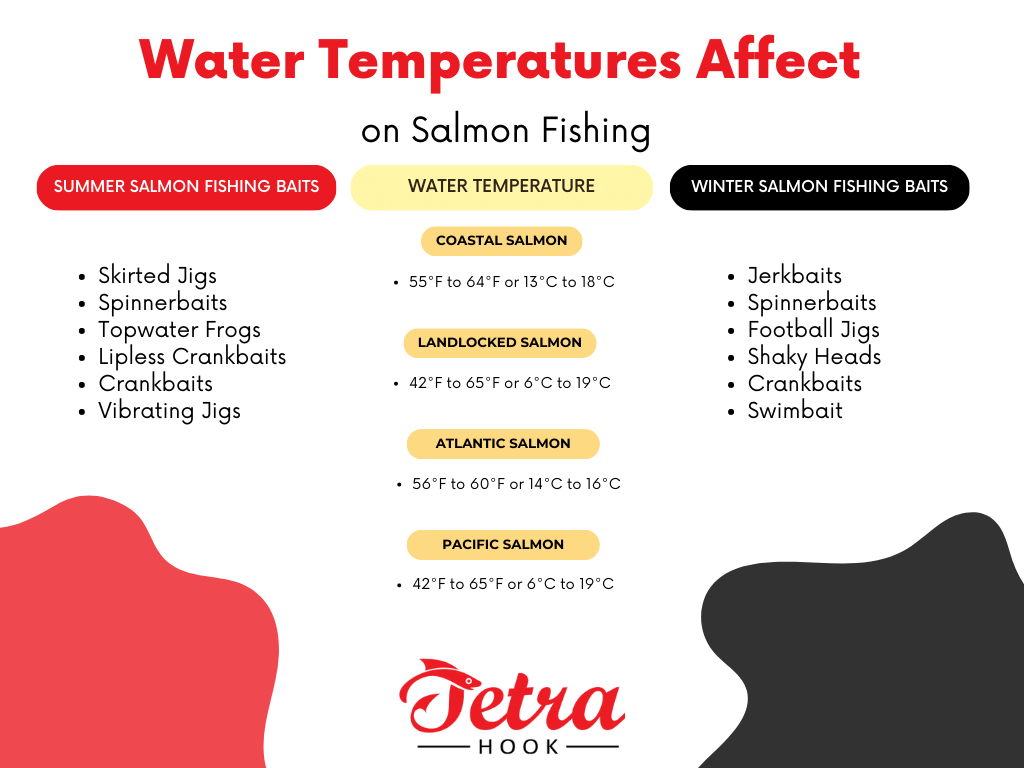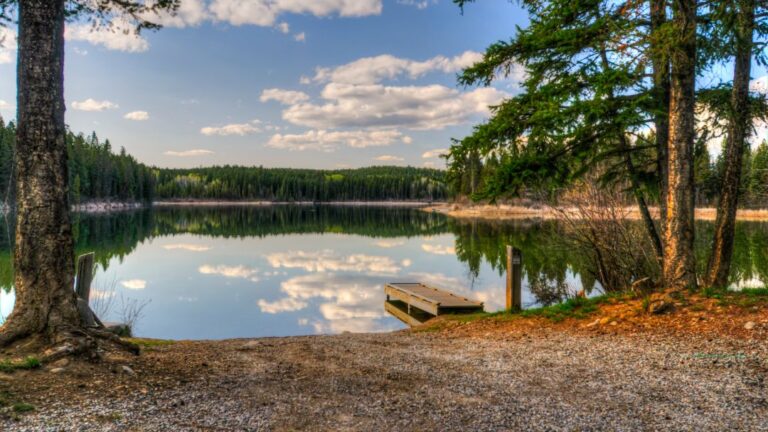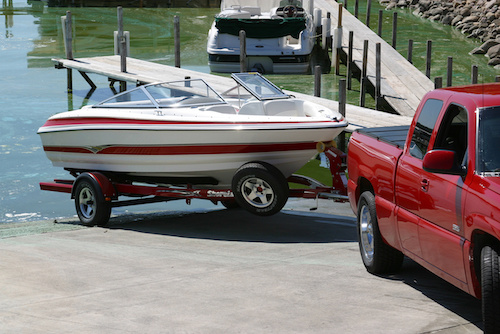Best Water Temperature For Salmon Fishing
Do you know water temperature plays a crucial role in your fishing success? The same goes for salmon, whether it is small or large salmon. They react differently if the temperature changes.
Salmon fishes’ behavior changes throughout various seasons. What is the best water temperature for salmon fishing?
The best fishing water temperature for coastal salmon is 55-64° F, whereas 42° to 65° F is ideal for landlocked salmon. If you are targeting Atlantic salmon, the water temperature should be 56-60°F. In contrast, 42-48°F is the best water temperature for pacific salmon.
How Do Water Temperatures Affect Salmon Fishing?
Water temperatures can significantly affect your salmon fishing in various ways. You may have the best salmon fishing spinning rods and reels, but still, you can have a hard luck catching any Salmon.
Anglers have to change their fishing techniques depending on the water temperature.

Metabolic Rate
The first important aspect is metabolic rate. When the water temperature increases, the metabolic rate of salmon fishes changes.
For example, their metabolic rate will double if the water temperature rises by 10° C.
As a result, salmon will need more oxygen to sustain bodily functions.
But why changes in the metabolic rate will affect your fishing? It will change the feeding behavior and digestive habits of salmon fish.
Migration Patterns
Salmon are cold-blooded fish who prefer clean, oxygenated water to live peacefully. They love to thrive and swim around when the temperature is between 40˚F to 50˚F.
But their migration pattern changes when the water temperature changes.
The top water of seawater or freshwater has almost similar temperature to the air temperature.
If the temperature is too less than 40˚F or more than 65˚F, salmon will stay in the deeper water where the temperature is more comfortable.
Anglers will have to adjust their fishing tactics based on how salmon change their behavior.
Salmon Fish Availability
If the water temperature is extremely cold or hot in a particular location, fish may move to another sea or river where they find it more comfortable.
In many cases, salmon may move to the bottom of the water to live comfortably.
Generally, a fishing rod can reach up to 11 to 12 feet if you use the most extended option.
But, if salmon go beyond your range, you can’t catch any fish.
You will have no option but to leave the space if you are only after salmon fish.
Bait Concentration
Salmon fish are more active in summer than in winter unless the temperature is extreme in both seasons.
In winter, when the water temperature becomes less than 40˚F, salmon becomes less active.
They prefer to stay in a place without swimming around unnecessarily.
You will need finesse, brightly colored, and flashy baits to attract salmon during the winter season.
The followings are some top baits you can use during summer and winter for salmon fishing.
| Summer Salmon Fishing Baits | Winter Salmon Fishing Baits |
| Skirted Jigs | Jerkbaits |
| Spinnerbaits | Spinnerbaits |
| Topwater Frogs | Football Jigs |
| Lipless Crankbaits | Shaky Heads |
| Crankbaits | Crankbaits |
| Vibrating Jigs | Swimbait |
What Is The Ideal Water Temperature For Salmon Fishing?
The best water temperature for salmon varies depending on freshwater or saltwater and particular location.
The followings are the various salmon fishes based on their location.
Coastal Salmon
The ideal water fishing temperature for coastal salmon ranges from 55° F to 64° F or 13°C to 18°C.
Anglers can catch a substantial amount of salmon from coastal areas such as Massachusetts, Texas, Alaska, Florida, Washington, California, etc.
Landlocked Salmon
The best temperature for landlocked salmon is between 42°F to 65° F or6°C to 19°C.
New York, Michigan, Minnesota, Pennsylvania, Wisconsin, Indiana, Illinois, and Ohio —are the top popular locations where you can find various types of salmon.
Atlantic Salmon
The ideal water fishing temperature for coastal salmon ranges from 56° F to 60° F or 14°C to 16°C.
Atlantic salmon, known as the king of salmon fish, have three groups: North American, Baltic, and European.
Maine is the only place where you will find native populations of Atlantic salmon.
Pacific Salmon
Southern Oregon or Northern California Coast is the best location for Pacific Salmon fish.
The best temperature for Pacific salmon is between 42°F to 65° F or6°C to 19°C.
| Salmon From Various Locations | Ideal Temperature |
| Coastal Salmon | 55° F to 64° F or 13°C to 18°C |
| Landlocked Salmon | 42°F to 65° F or6°C to 19°C |
| Atlantic Salmon | 56° F to 60° F or 14°C to 16°C |
| Pacific Salmon | 42°F to 65° F or6°C to 19°C |

Various Salmon Fish And Their Ideal Water Temperature
Salmon fish is available in mainly five types. But, there are two other versions, only available in Asian countries.
Their water temperature preference varies based on their type. The below listed small table will give a complete idea regarding their ideal water temperature.
| Fish Type | Ideal Water Temperature |
| Chinook | 13°C to 20°C |
| Coho | 5°C to 14°C |
| Chum | 13.5°C to 23°C |
| Sockeye | 13°C to 20°C |
| Pink | 9°C to 14°C |
| Masu | 15°C to 22°C |
| Amago | 8°C to 13°C |
How do Seasonal Variations Affect Salmon Fishing?
The water temperature of freshwater and saltwater varies in various seasons. It can affect your fishing experience significantly.
Salmon fish react differently and change their behavior depending on the water temperature.
| Season | Months | Average Water Temperature |
| Spring | April, May, & June | 48°F to 74° F |
| Summer | July & August | 65°F to 75° F |
| Fall | September & October | 55°F to 65° F |
| Winter | November, January, February, & March | 35°F to 45° F |
Now, let’s learn how seasons various affect the availability of multiple types of salmon.
Chinook Salmon
This fish is also known as King Salmon. It is available almost all year round.
They have a smaller spawning period, ranging from October through December. You can catch various sizes of Chinook salmon from mid-January to early November.
But, you will only get very few numbers of Chinook salmon after mid-November to late December.
Compared to other months, King salmon are less available from mid-October to Mid January.
Coho Salmon
This is a mid-range species larger than pink or chum salmon but smaller than sockeye or king.
Its spawning period starts from early September to late November. The best time to catch them is from mid-June to late October.
Plus, you will see a significant drop in fishing from mid-September to late October.
They are less likely to be available from early November to mid-June.
Sockeye Salmon
This salmon species is one of the hardest-fighting fish. Their spawning session starts in early June and ends in late July.
The ideal time for catching Sockeye Salmon is early August to late September.
They are fully available in these two months. But very few numbers of Sockeye Salmon are available for fishing in other months.
Chum Salmon
If you are a sport angler or recreational fisherman, you know how fun it is to catch Chum Salmon. They are known as hard fighters.
Their spawning session starts in mid-July and ends in early September. The best time to catch them is from early September to early November.
They are moderately available in these three months. Due to many stressors and threats, their numbers have decreased.
Pink Salmon
This is a minor type of salmon that is simple to hook and catch. Boat anglers love to catch it.
Pink salmon is widely available in the Great Lakes. Their spawning session is between August to October.
July to September is the ideal time for catching Pink salmon. However, they are highly available during August month.
| Salmon Type | Spawning Period | Best time for fishing |
| Chinook Salmon | Early September To Late November | Mid-January To Early November |
| Coho Salmon | Early September To Late November | Mid-June To Late October |
| Sockeye Salmon | Early June To Late July | Early August To Late September |
| Chum Salmon | Mid-July To Early September | Early September To Early November |
| Pink Salmon | Early August To Late October | Early July To Late September |
Is Cold Water Or Hot Water Better For Salmon Fishing?
Salmon fish prefer to live in cold water. However, it should not be too cold. Otherwise, they will go deeper and be less.
The temperature should be between 55°F to 65° F, mainly in late summer, from August to September.
During this period, the water is cold but not freezing down. Salmon fish becomes more active and eat more frequently to gain energy.
If the temperature is more than 68°F, salmon will go deep to find colder water in the bottom area.
Hence, anglers should catch salmon fish when the temperature ranges between 55°F to 65° F. They behave naturally in this condition.
When the water temperature is too high or low, it will change its behavior and may stay in the lower portion of the water for a long time.
Final Thoughts
When it comes to salmon fishing, techniques and fishing skills are essential. But a good idea of the weather conditions and water temperature is crucial.
It allows anglers to utilize the best technique based on the situation. We have already outlined the best water temperature for salmon fishing.
You want to choose the essential fishing gear and other items depending on the behavior of the salmon fish.



